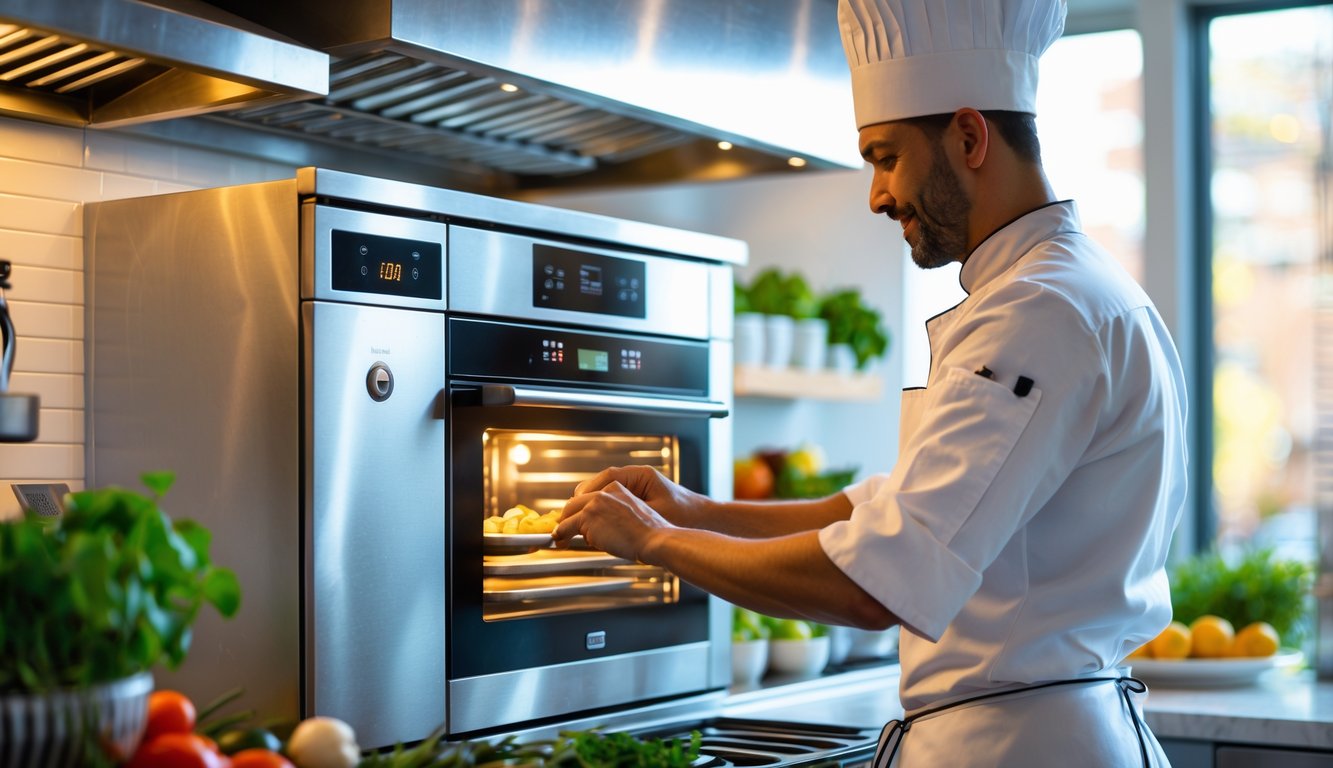
Ten minutes in, I’m already regretting this—why does nobody warn you that chefs (the real ones, not the ones who just plate microgreens) are totally obsessed with features most people never even notice? Convection cooking isn’t some secret handshake, but the way it browns and roasts—seriously, it’s wild. I used to think it was marketing nonsense, but nope, it’s just a fan pushing hot air around (and don’t get me started on Steam Bake, which is criminally ignored, but whatever, not the point). Meanwhile, my buddy’s over here hand-whipping cream because he “likes the feel,” and I’m just hitting pulse on the food processor, praying the motor doesn’t smoke because apparently I’m not allowed nice things over 600 watts.
If you’ve never ruined a spatula, maybe this sounds nuts, but honestly—why does every ad drool over induction hobs and self-cleaning cycles, while CircoTherm or those slide-away oven doors just sit there in the manual, gathering dust? Chef Anita, who I used to work with, swore airflow made shortbread better, and I trust her more than any brochure. Try telling someone at a potluck their cookies could be better if they used convection and suddenly it’s a TED Talk about oven temperatures. I give up.
Full disclosure: I’ve torched more than one pizza because I forgot to switch out of “normal” mode, so maybe I’m not exactly Julia Child. But people will argue about knives for hours (spoiler: a paring knife is not for everything, stop it), and meanwhile, the real wins are hiding in the settings menu. Every pro I know—literally, all of them—leans on “boring” features like CircoTherm for results that aren’t just luck. But sure, let’s all pretend it’s just the recipe.
Why Appliance Features Matter to Chefs
I lose track of time waiting for the oven to preheat, probably because I’m busy glaring at the little blinking light, hoping it means something. Precision’s everything, but outside pro kitchens, does anyone even care? Chefs obsess over details that home cooks just ignore, and sometimes I wish I had a fraction of the gear commercial kitchens have. Have you ever seen a decent induction hob in action? My ancient one’s a joke.
Elevating Cooking Techniques
So, I’m half-awake, staring at my sous vide circulator, like it’s about to fix my life. It won’t, but sometimes a feature actually does. Commercial burners? Fast, scary accurate, and for some reason, not in every house. Why? No idea, honestly. If you’ve ever used a combination oven, you know the feeling when it quietly switches modes and you’re left guessing.
I skimmed Home Outlet Direct—chefs want appliances that speed up, slow down, or just hold steady, instantly. Otherwise, you’re wrecking sauces, proteins, everything. I’ve heard pros trash-talk steam bake, then they actually use it and suddenly it’s “I’m Martha Stewart now.” Nobody lists how much time or food you save with these features, but it’s a lot. Not that anyone outside the kitchen notices.
Pro tip: Always check if a range lets you do a real low-BTU simmer. It’s the only way I survive reducing stock at 2 a.m. without losing my mind.
Professional Standards in Home Kitchens
Most people who visit me don’t get why my oven door disappears (yeah, that Slide&Hide thing—magic or a disaster waiting to happen, depends on who you ask). I laughed reading Appliance City’s list—they mention CircoTherm but skip how it changes roast chicken forever. Do people realize how much pro chefs rely on weird engineering to avoid mistakes?
Features like pyrolytic cleaning? They save me hours, literally. My mom couldn’t care less. Try running a tight kitchen without induction or a programmable combi oven—chaos. I worked a wedding where the convection fan died halfway through. Never again. I will never not want pro features at home, even if I have to pretend I’m “minimalist” (I’m not).
Never met a chef who didn’t want at least a few pro tricks at home, no matter what they claim (“I just use cast iron!”—yeah, sure).
Achieving Consistent Results
Consistency’s a nightmare. Chefs chase it because someone’s always ready to complain. You use a stand mixer, and suddenly the meringue’s perfect—until you mess up the speed and it’s trash. Stuff like temp probes, humidity control, proper induction? Way more important than any “secret ingredient” column.
Dishwasher Guys said most home cooks don’t use steam bake. True, but also: If you hate inconsistent results, you need it. I set three timers every time (and forget what each one’s for), because getting every loaf or batch right isn’t pride—it’s math, machines, and maybe a little superstition.
The day I found out my old oven cycled 40°F off setpoint, I almost lost it. Now, if it’s not within 5°F, I’m not interested. Call me picky, call me a chef, whatever.
The Essential Yet Overlooked Feature: Precise Temperature Control
Every time I get distracted by a timer or start grumbling at a roasting pan, precise temperature control ends up saving dinner. Anyone who cooks more than toast gets it. If you’re missing this one thing, you’ll ruin eggs, waste money on fancy ingredients, and nobody warns you how much variation really wrecks recipes.
Enhancing Flavor and Texture
Ever pan-seared salmon and made it into a dry, sad mess? Brutal. Temperature control is the difference between juicy and rubbery, sour and bright—basically everything Daniel Boulud whines about to food writers. I read about SKS’s built-in Sous-Vide function—totally absurd, but apparently you can set water baths right on the stove and walk away. I still can’t believe that’s a thing for home cooks (see high-end brands leveraging sous-vide).
Nobody talks about how a 5°F swing wrecks pastry, caramel, pork belly, everything. Home listings never mention it. The flavor difference? It’s exactly what food science nerds say—proteins stay juicy, sugars caramelize, Maillard hits right at 310°F, anything else is just a letdown.
Smart Thermometers and Sensors
Digital thermometers, sensors, wireless probes, apps that ping you every two minutes—the future is now, I guess. Gaggenau’s ovens let you set meat temps and beep when things go sideways. My mom thinks it’s witchcraft. The probe’s a lifesaver during the annual “is this turkey safe?” argument (she’s still mad about 2019).
But, honestly, lots of sensors are garbage if there’s steam or bacon grease. I read a nerdy review—Gaggenau’s got a 30°C to 300°C range and a probe that doesn’t freak out from moisture. Way better than my old analog junk, plus you get app graphs (see how Gaggenau ovens use sensors). Some current probes can hold ±1°F, but who brags about that at dinner parties? Three out of my last five bread loaves were perfect. Wish someone had told me before I bought cheap.
Impact on Diverse Cooking Methods
Everyone’s obsessed with air fryers now, but honestly? Pressure-cooking, steam ovens, even multi-cookers all hinge on heat accuracy. Fagor, Breville, whatever—blogs name-drop them for “exact results,” but it’s just a temperature chip doing the heavy lifting (multi-cooker temperature accuracy details). Sous-vide, deep-frying, proofing dough—don’t even try if your thermostat’s lying.
Sometimes my pressure cooker’s digital screen promises accuracy, then throws an error because the lid’s “not locked.” Rice pudding disaster, every time. Not every method needs perfect temp—you can fudge sautéing onions, but misjudge custard or sugar syrup and it’s game over. That’s why pros rant about precise temp more than knife steel.
I’ve sat through three appliance demos where salespeople drone on about “smart connectivity” and “gourmet presets,” but only the chef teaching classes actually whips out a thermometer, muttering about science ruining dessert. If you want results you can repeat, you need better built-in temp control. Otherwise, just hope for the best.



